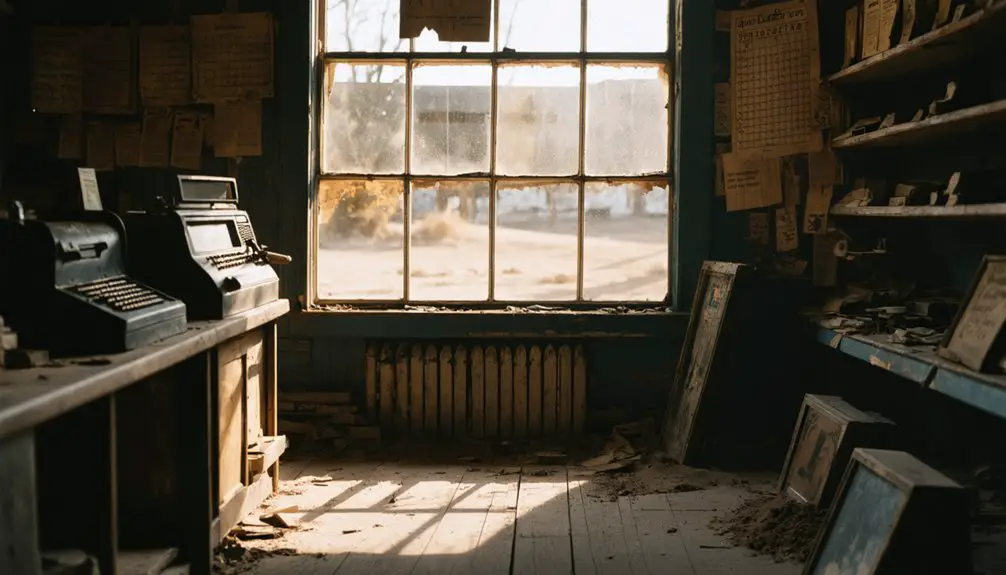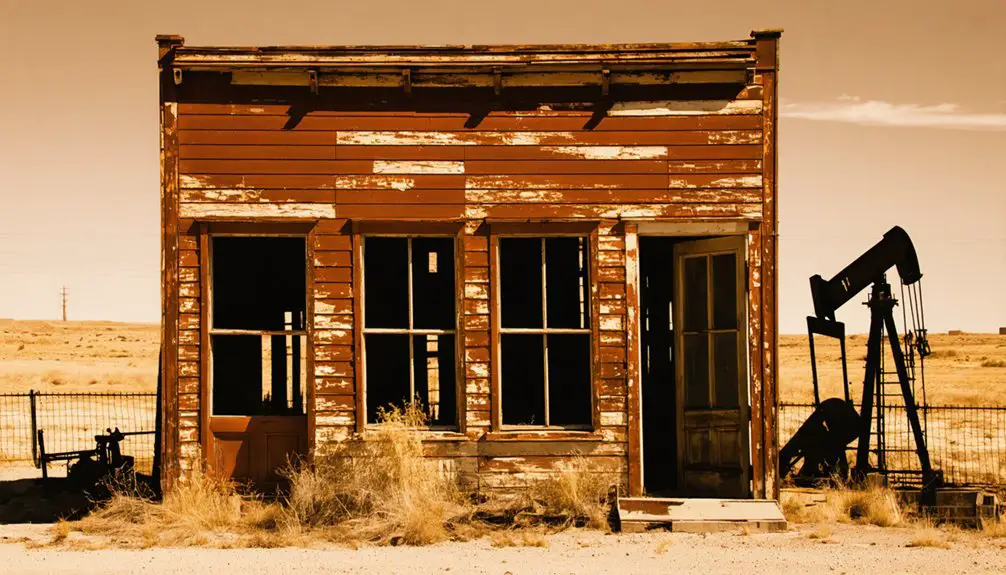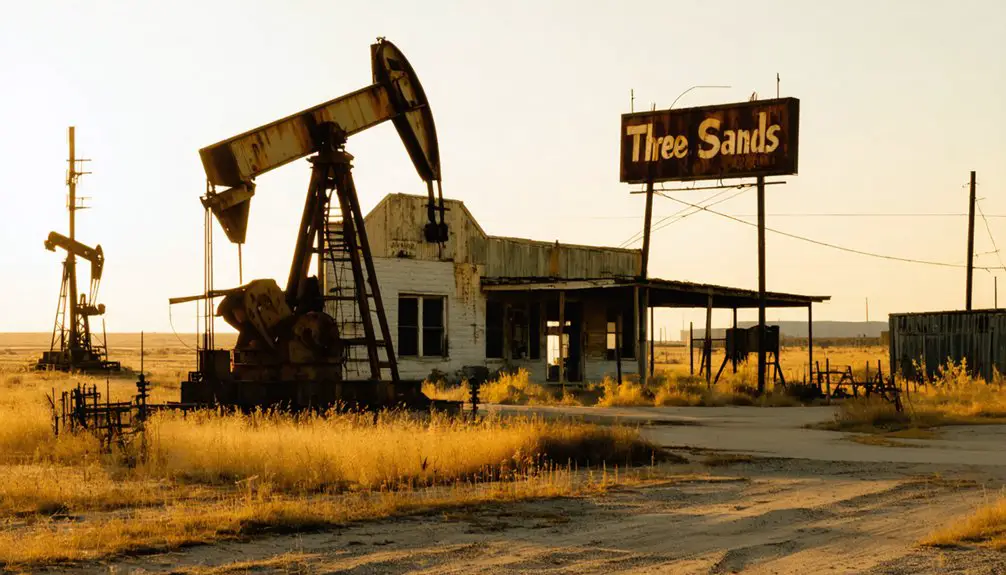Three Sands emerged after a massive oil discovery in Oklahoma’s Glenrose Township on June 30, 1921. You’ll find it’s a classic American boom-to-bust story, where a 500-person farming community exploded to 10,000 residents by 1923. The town boasted a $60,000 gymnasium, theaters, dance halls, and produced up to 28 million barrels of oil annually during its peak years of 1923-1925. By 1957, Three Sands had vanished completely, leaving only concrete foundations and the Riverview cemetery as silent witnesses to its glory days.
Key Takeaways
- Three Sands transformed from a 500-person settlement to a 10,000-resident boomtown after oil discovery in 1921, before becoming a ghost town.
- The town flourished between 1923-1925 with massive oil production, featuring a $60,000 gymnasium, theaters, and extensive housing developments.
- Rapid decline began after 1924, with population dropping to hundreds by 1930 as oil production decreased.
- Infrastructure gradually disappeared with rail closure in 1942, school closure in 1946, and post office shutdown in 1957.
- Only concrete foundations and Riverview cemetery remain today as physical evidence of this once-thriving Oklahoma oil boomtown.
The Birth of an Oil Boomtown
The discovery of oil on June 30, 1921, in Noble County’s Glenrose Township sparked the birth of Three Sands, Oklahoma’s newest boomtown. When the initial well gushed 3,000 barrels daily, you’d have witnessed a swift transformation of the landscape as workers flooded the area.
By November 1922, you’d have found a bustling community sprouting from what was once empty prairie. First-hand accounts from B.F. Conaghan provide vivid details of daily life in the booming oil town.
Originally called Comar, after the prominent Comar Oil Company, the town’s identity emerged from three productive oil sand layers in the region. You’d have seen the population explode from 500 to nearly 2,000 residents within months. The company built a massive $60,000 gymnasium that could accommodate 2,500 people for community gatherings and entertainment.
The boomtown consolidated several smaller settlements, including Four Ways and Kanolka, creating a sprawling community that stretched along the Tonkawa-Perry road with tents, shacks, and board houses dotting the terrain.
Peak Years and Economic Glory
During Three Sands’ prime years of 1923-1925, you’d have witnessed an economic powerhouse pumping between 23 and 28 million barrels of oil annually from its rich 8-square-mile field.
The oil wealth transformed this Oklahoma prairie into a bustling hub where you’d find 11 boarding houses, theaters, and machine shops serving a population that swelled past 1,000 residents.
Like many other Oklahoma boomtowns, Three Sands emerged rapidly following the discovery of valuable natural resources.
The town’s wild character made it a shanty settlement where temporary structures dominated the landscape.
Boomtown dynamics shaped every aspect of life. You’d see distinctive company housing painted in telling colors – Comar’s green, Gypsy’s gray, and Carter’s gold structures dotting the landscape.
Despite Prohibition, bootleggers kept spirits flowing, while packed boarding houses like “Two-Ton Tilly’s” and “Three Sands Blanche” housed the workforce.
Lumber was so precious, carpenters stood guard over their materials day and night.
Daily Life in Three Sands

If you’d lived in Three Sands during its peak years, you’d have called a company-built row house, tent, shack, or crowded boarding house your home, with housing options color-coded by oil companies like Comar’s green houses or Gypsy’s gray ones.
After long days in the oil fields, you could’ve enjoyed shows at the Cozy Theater, danced at the town’s large dance hall, or gathered at the 2,500-seat Comar gymnasium for community events.
Your daily needs would’ve been met by the town’s cafés, grocery stores, and company cafeterias, which formed the commercial backbone of this bustling oil community until its decline.
Housing and Living Conditions
As Three Sands rapidly expanded in the early 1920s, residents initially lived in a makeshift assortment of tents, shacks, and dugouts due to limited lumber availability.
To address housing shortages, oil companies constructed rows of “camps” – basic shotgun-style houses with three to four linear rooms. You’d recognize different company affiliations by their distinct paint colors: green for Comar, gray for Gypsy, and gold for Carter.
Living expenses were offset by boarding houses run by local characters like “Two-Ton Tilly” and “Three Sands Blanche,” which stayed packed with workers.
While conditions were rough, you’d find community amenities developing around you – from Comar’s large employee cafeteria to a 2,500-seat gymnasium.
Local entertainment included the Cozy Theater and a two-story dance hall, while bootleggers kept spirits flowing despite prohibition.
Social Activities After Work
While the demanding oil fields kept Three Sands workers busy throughout the day, vibrant social activities emerged after sunset at local gathering spots. Popular boarding houses like “Two-Ton Tilly” and “Three Sands Blanche” served as bustling social hubs where you’d find workers sharing meals and stories after their shifts.
Despite Prohibition’s restrictions, nighttime activities flourished through an underground network of bootleggers. You could count on these social gatherings to feature:
- Clandestine alcohol deliveries by local couriers
- Impromptu sports and physical contests between oil field workers
- Community events at the schoolhouse for families
The town’s merchants and oil company officials often collaborated on community affairs, while local cafes and grocery stores doubled as informal meeting places where you’d find residents socializing outside work hours. Much like the residents of Cloud Chief’s 700 residents, Three Sands maintained a close-knit community atmosphere through its peak years.
Essential Services and Stores
Three essential services formed the backbone of daily life in Three Sands: grocery stores, boarding houses, and the post office.
You’d find your basic food needs met at the town’s first business, a simple grocery store and cafe in a shack on the C.C. Endicott farm, while Comar Oil Company’s large cafeteria served both workers and residents.
For housing, you could’ve stayed at popular boarding houses run by “Two-Ton Tilly” or “Three Sands Blanche,” which were constantly full.
If those weren’t available, you might’ve landed in one of the company-built “shotgun” houses, painted in distinct colors like Comar’s green or Gypsy’s gray.
The post office kept everyone connected until 1957, marking the final chapter of this bustling boomtown’s story.
The Architecture of Impermanence

During the frenzied oil boom of the 1920s, Three Sands’ architecture reflected its hurried, temporary nature through hastily constructed buildings and makeshift shelters.
These impermanent structures ranged from simple tents to wooden shacks, while precious lumber remained under constant guard due to severe shortages.
Desperate for shelter, residents cobbled together makeshift homes from scarce materials, protecting lumber supplies like precious gold.
Oil companies left their mark through distinctive color-coded housing:
- Comar painted their row houses green
- Gypsy chose gray
- Carter selected gold
This transient architecture defined the townscape, with “shotgun” style homes featuring narrow, linear designs of three to four rooms.
While some permanent touches emerged, like Comar’s $60,000 gymnasium and multiple theaters, most buildings maintained their provisional character with basic shiplap or plank construction.
Today, only concrete foundations remain as evidence to Three Sands’ brief but vibrant existence.
Social Scene and Community Spirit
You’d find Three Sands’ social life centered around its two-story dance hall and multiple theaters, including the popular Cozy Theater, which provided much-needed entertainment for the hard-working oil field community.
The $60,000 gymnasium, built by Comar Oil Company, became a hub for community gatherings, hosting up to 2,500 people for various social events and entertainment.
Despite the harsh living conditions of tents and shacks, the town’s residents forged strong bonds through shared experiences at perpetually-full boarding houses like “Two-Ton Tilly” and “Three Sands Blanche,” while local bootleggers kept spirits flowing during prohibition.
Entertainment and Leisure Life
Despite its rough-and-tumble boomtown nature, Three Sands quickly developed a vibrant social scene centered around several key entertainment venues.
You’d find the Cozy Theater operating by December 1922, while a second theater was already under construction. The massive $60,000 Comar Oil Company gymnasium could seat 2,500 people for cultural events and community gatherings.
Three major entertainment hubs shaped daily life:
- A bustling two-story dance hall that opened in January 1923
- Company-built boarding houses like “Two-Ton Tilly” that served as social centers
- Multiple cafes and grocery stores that doubled as gathering spots
While Prohibition was officially in effect, you wouldn’t have trouble finding bootlegged spirits, adding to the town’s lively nightlife and entertainment scene that helped workers escape their demanding oil field routines.
Community Bonds Despite Hardships
Although Three Sands’ residents faced harsh living conditions and constant population flux, they forged remarkably strong community bonds through their shared experiences.
You’d find workers gathering at the company-built facilities, like Comar’s massive gymnasium that seated 2,500 people, or at local boarding houses run by colorful characters like “Two-Ton Tilly” and “Three Sands Blanche.”
The community’s resilience showed in how they adapted to their circumstances – even during Prohibition, bootleggers kept social traditions alive.
Miles of interconnected sidewalks physically linked the community, while shared spaces like the company cafeteria and local schools served as social anchors.
Despite living in simple shotgun houses or makeshift shelters, residents found ways to build lasting connections that sustained them through the boom-and-bust cycle.
The Inevitable Decline

While Three Sands initially thrived as a booming oil town reaching 10,000 residents by 1923, its decline proved swift and irreversible.
The dramatic population trends mirrored the economic shifts in oil production, dropping to 7,000 by 1924 and mere hundreds by 1930.
The town’s demise followed a predictable pattern as key infrastructure vanished:
- The rail spur to Marland was abandoned in 1942
- The high school closed its doors in 1946
- The last grocery store shuttered by 1951
You can trace the town’s final descent through the closure of its post office in 1957.
Without alternative industries to sustain the community, Three Sands gradually faded into a ghost town, leaving only concrete foundations and the Riverview cemetery as evidence of its existence.
Legacy in Oklahoma’s History
Three Sands’ physical decline hasn’t diminished its enduring impact on Oklahoma’s oil industry heritage.
You’ll find its historical significance deeply woven into the state’s early oil boom narrative, where it produced an impressive 23-28 million barrels annually during its 1923-1925 peak.
While only concrete foundations and the Riverview cemetery remain today, the town’s legacy preservation efforts continue through museum exhibits and genealogy records.
You can trace Three Sands’ lasting influence through its pioneering corporate town planning, exemplified by distinctly colored company housing camps, and its role in rapid urbanization.
Though the once-bustling theaters, dance halls, and $60,000 gymnasium are gone, they represent an essential chapter in Oklahoma’s economic development, showcasing how oil discovery transformed rural landscapes into vibrant, if temporary, communities.
Frequently Asked Questions
What Happened to the Remaining Oil Deposits After Three Sands Was Abandoned?
You’ll find the remaining resources mostly untouched since abandonment, with the oil legacy trapped underground due to technological limitations and economic barriers that made extraction commercially unfeasible after 1957.
Were There Any Major Accidents or Disasters During the Oil Boom?
Like many boomtowns of that era, you’d have seen devastating oil boom disasters at Three Sands – from rig collapses to deadly explosions – due to nonexistent safety regulations and profit-driven operations.
How Did Native American Communities Interact With Three Sands Residents?
While limited records exist of cultural exchange, you’ll find Native Americans, especially Osage, maintained economic ties through oil royalties but experienced minimal documented community relations with Three Sands’ transient population.
What Environmental Impact Did the Oil Extraction Leave on the Area?
You’ll find extensive oil pollution in soil and groundwater, with high salinity plumes and toxic chemicals still present today. The extraction operations left lasting habitat destruction through salt scarring and soil degradation.
Did Any Famous People or Historical Figures Visit Three Sands?
You’ll find oilman E.W. Marland was the most notable visitor, while other famous visitors were mainly oil industry executives and wealthy royalty owners of historical significance to the region.
References
- https://en.wikipedia.org/wiki/Three_Sands
- https://www.youtube.com/watch?v=OpikOA1Ih94
- https://en.wikipedia.org/wiki/List_of_ghost_towns_in_Oklahoma
- https://www.okhistory.org/publications/enc/entry?entry=GH002
- https://www.ghosttowns.com/states/ok/threesands.html
- https://cherokee-strip-museum.org/three-sands/
- https://gateway.okhistory.org/ark:/67531/metadc2031358/
- https://aoghs.org/this-week-in-petroleum-history/march-3-2025/
- https://www.youtube.com/watch?v=5d-wHDTIbb0
- https://www.okhistory.org/publications/enc/entry?entry=PE023



